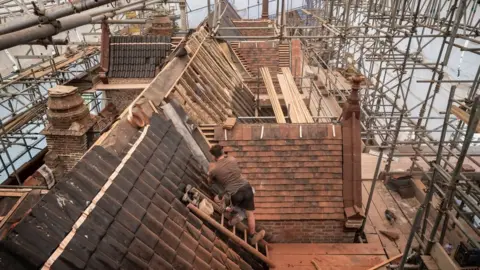National Trust adapts Oxburgh Hall's roof tiles for bats
 PA Media
PA MediaNew roof tiles fitted to a Grade I listed 15th Century manor house have been adapted to stop bats slipping off.
Oxburgh Hall in Norfolk was having its tiles replaced after they became weatherworn, cracked and damaged.
But after bats slipped off the glaze, the tiles were coated with paint mixed with sand of different sizes enabling the creatures to grip with their claws.
National Trust project manager David White said there were "numerous signs" of bats in roof spaces.
Conservationists selected tiles that looked the same as those used at the hall more than two centuries ago.
But experts had to develop the new non-slip coating for the tiles which were situated around 32 new bat openings on the roof.
Allow X content?
Mr White said: "There were signs of a maternity roost in the past, but the current use has been as day and night roosts for numbers of brown long-eared and common pipistrelle bats.
"We have worked with bat experts to create a new roost in the nearby Bell Tower and installed bat boxes in the trees on the north terrace to provide alternative roosting places whilst the roof works takes place.
"Currently the bell in the Bell Tower can't be rung, so as not to disturb the bats."
 Getty Images
Getty ImagesThe project to repair the roof started when a 150-year-old dormer window unexpectedly collapsed in 2016, exposing a structural weakness in the roof of the hall.
It was a condition of planning permission for the £6m re-roofing project that the National Trust protected the bats.
While bats would not have come to harm from the slippery tiles, they would have lost their safe roosting spaces in the roof, a National Trust spokesman said.
 PA Media
PA MediaThe project has fixed the structural problems, repaired the roof, and dismantled and rebuilt all of the 14 dormers that were added in the 19th Century.
Oxburgh Hall's 27 distinctive chimneys, made with moulded hand-made bricks, have also been rebuilt.
The moated hall, in Oxborough near King's Lynn, was built for Sir Edmund Bedingfeld in 1482 and has been owned by the National Trust since 1952.
 National Trust
National Trust
Find BBC News: East of England on Facebook, Instagram and Twitter. If you have a story suggestion email [email protected]
